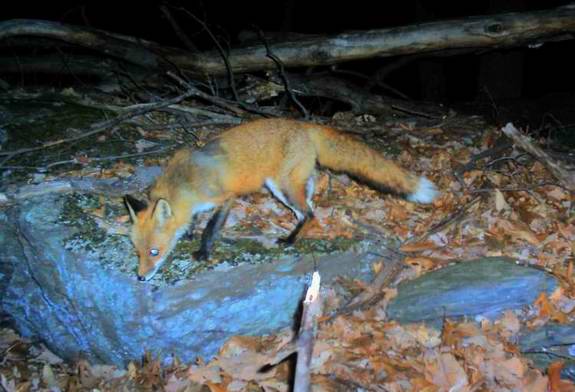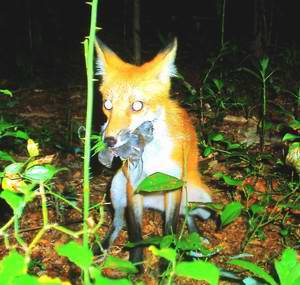|
Return to Hiker's Notebook Home Page
Common Name: Red Fox, Rotfuchs (German), Renard (French), Silver, black or cross fox (English), Volpe (Italian), Zorro (Spanish) - Fox is from the German fuchs which originates from the Indo-European base puk meaning thick-haired and bushy from the Sanskrit puccha meaning tail.
Scientific Name: Vulpes vulpes - The Latin word for fox is vulpes.
The red fox is geographically the most widely distributed of all of the carnivores, having native populations in Eurasia, Africa and North America. Their successful dispersion is testimony to the adaptability and intelligence that are manifest in the hackneyed though appropriate aphorism "sly as a fox." The vulpine foxes first appear in the fossil record of the Miocene Epoch of the Tertiary Period about 10 million years ago, a time when mammals began to develop the characteristics of their modern progeny; the red fox diverged as a separate species from the related cape fox (V. chama, now native to southern Africa) about 5 million years ago. The intervening millennia have witnessed the spread and concomitant Darwinian variation of the red fox to the extent that there are currently 48 recognized subspecies.
The pedigree of the native North American red fox is subject to some conjecture due to the anthropogenic introduction of the European red fox early in the colonization process. In the pre-Columbian period, Vulpes fulva was the native red fox species. It is hypothesized that its habitat was predominantly boreal and that its range was accordingly limited to the northern and more montane reaches of the continent. When the English colonists came to the Americas, they brought their culture, which included the hunting of the European red fox (the fox hunt was famously characterized by Oscar Wilde as "the unspeakable in pursuit of the uneatable"). Robert Brooke is generally credited as being the first American fox hunter, having immigrated to Maryland on 30 June1650 with his family and a pack of hounds. The early fox hunters of necessity sought other quarry such as the gray fox, since the range of the red fox extended south only to Pennsylvania and New Jersey and were unknown in the austral zone. European red foxes (V. vulpes) were introduced and released into the wild between 1650 and 1750 in an apparent attempt to replicate the traditional English experience. The interbreeding of the V. vulpes with V. fulva resulted in the commingling of the species to the extent that in the mid-Atlantic and southern areas, they are now considered to be conspecific, both belonging to the same subspecies: Vulpes vulpes fulva. This taxonomy is still subject to some disputation; however, most references include V. v. fulva as one of the 10 to 12 subspecies of the red fox in North America.
The diversity and geographic dispersion of the subspecies of red fox are indicative of the successful adaptation of survival traits that characterize their behavior, most notably prodigious hunting skills, an omnivorous diet, and a supportive social structure. In what may be an example of convergent evolution (when two different species develop similar characteristics in response to external forcing factors), the cat and the fox share several behavioral and physical similarities. Foxes hunt like bobcats, taking advantage of their senses, stealth and speed (up to 30 miles per hour) in prosecuting their prey, primarily voles. The typical encounter consists of a stealthy approach punctuated by a leap of up to fifteen feet that ends with the startled rodent ensconced in the fox's jaws, its end assured by a quick severance of the spinal cord.
Foxes have cat's eyes, the yellow pupil is slit vertically as a adaptive departure from the round pupils of the other canines. This arrangement affords foxes and cats the advantage of closing the pupil more tightly for greater acuity under diverse lighting conditions. It has also been postulated that slit-pupil eyes are more sensitive to the movements of small objects at ground level. The low light sensitivity of the fox's eyes is accentuated by their structure, a preponderance of rod cells over cone cells, the latter being the purveyors of color and detail. Therefore the fox is likely myopic, able to see nearby prey and vegetation in dimly lit tableaux but befuddled in bright light. Since red foxes are crepuscular predators, night vision adaptations so as to be able to detect their prey in the waning sunlight at dusk are consistent with the precepts of evolutionary survival.
But it is the sense of hearing that sets the fox apart as the consummate stalker. Studies conducted on fox behavior in Finland found that their ability to detect low frequencies was paramount to their venery. As documented by MacDonald and Reynolds in Canid Specialist Group's Canids, red foxes were able to pinpoint their prey to within one degree between the frequencies of 700 and 3,000 Hertz. Similar studies have posited a predatory success rate of 90 percent between the frequencies of 900 and 14,000 Hertz. The low frequency susurration of the unwitting rodent in egress from its burrow is sufficient to alert the fox; in the winter months, the noise of tunneling through the snow affords the same result. Low frequency sensitivity also affords a warning of an approaching threat at distances up to about 100 meters.
Meadow voles are a dietary staple of red foxes, up to fifty percent of their
caloric intake in some habitats (photo below from Smithsonian Institution
Megatransect 2008). However, foxes are manifestly omnivorous in their feeding
practices and will eat almost
The stealthy, solitary fox of the hunt is socially gregarious when it comes to the hearth, an underground den or earth which is about two meters underground with a network of access tunnels up to 10 meters in length. The hierarchy of the social unit is a monogamous pair together with their most recent brood of kits frequently assisted by the subordinate female siblings of the dominant mated vixen. Any promiscuous activity on the part of the lesser females is likely to result in stern retribution, a possible explanation for the use of the term vixen to refer to a malicious and generally odious woman. The male is supportive following parturition and assists the female in providing food to the pups, the hunt, however, is still a singular affair. After about 6 months, the male offspring depart and establish their own territories at a range of about 20 miles from the original den; the female offspring generally remain in the immediate natal vicinity.
The interwoven history of foxes and humans has spawned a rich cultural narrative that ranges from Aesop's "Fox and the Grapes" to Joel Chandler Harris's Brer Fox. In the former, the fox is characterized as a shallow rationalist, declaiming that the grapes he cannot reach are too sour anyway, the moral being that it is easy to disdain that which is unattainable; in the latter, the fox is crafty to a fault, bested by the chicanery of Brer Rabbit and the tar baby. The French renard is an eponym for a peasant-hero character Reynard popularized in the stories of Pierre de Saint Cloud in the 12th Century, the anthropomorphized fox outwitting the nobles and priest of the first and second estates. The renard replaced the original French goupil due to the superstitions of farmers who considered using the vernacular name of the fox was bad luck. The Spanish fox is zorro, the eponymous folk hero in possession of the cunning and stealth that the name implies. |

 anything that they can catch, including but not limited to squirrels,
opossums, raccoons, skunks and even domestic cats and small dogs. The "fox in
the henhouse" is not a vapid maxim, as foxes can and do prey on domestic fowl;
they are considered a serious threat to free range poultry. The vulpine visit
to an enclosed chicken coop is often an apparently frenzied attack evidenced
by numerous headless chickens amid scattered feathers. Red fox predation is a
boon or a bane according to the desirability of their quarry; they are a
threat to ground dwelling birds such as mallards and grouse, but beneficent to
the human agrarian efforts in the eradication of rodents and rabbits. In
summer and fall when alternative foods are available, opportunistic foxes turn
to insects, fruit, nuts and grain for sustenance, preferring blueberries and
raspberries. If faced with a dearth of alternative food resources, even human
refuse and animal carrion are consumed. The relatively meager size of red fox
prey is a matter of availability and digestive capacity; the red fox has a
very small stomach for a canine, about half that of a wolf or dog relative to
weight. Therefore, foxes eat relatively scantily and of necessity cache excess
portions of larger kills for later consumption.
anything that they can catch, including but not limited to squirrels,
opossums, raccoons, skunks and even domestic cats and small dogs. The "fox in
the henhouse" is not a vapid maxim, as foxes can and do prey on domestic fowl;
they are considered a serious threat to free range poultry. The vulpine visit
to an enclosed chicken coop is often an apparently frenzied attack evidenced
by numerous headless chickens amid scattered feathers. Red fox predation is a
boon or a bane according to the desirability of their quarry; they are a
threat to ground dwelling birds such as mallards and grouse, but beneficent to
the human agrarian efforts in the eradication of rodents and rabbits. In
summer and fall when alternative foods are available, opportunistic foxes turn
to insects, fruit, nuts and grain for sustenance, preferring blueberries and
raspberries. If faced with a dearth of alternative food resources, even human
refuse and animal carrion are consumed. The relatively meager size of red fox
prey is a matter of availability and digestive capacity; the red fox has a
very small stomach for a canine, about half that of a wolf or dog relative to
weight. Therefore, foxes eat relatively scantily and of necessity cache excess
portions of larger kills for later consumption.